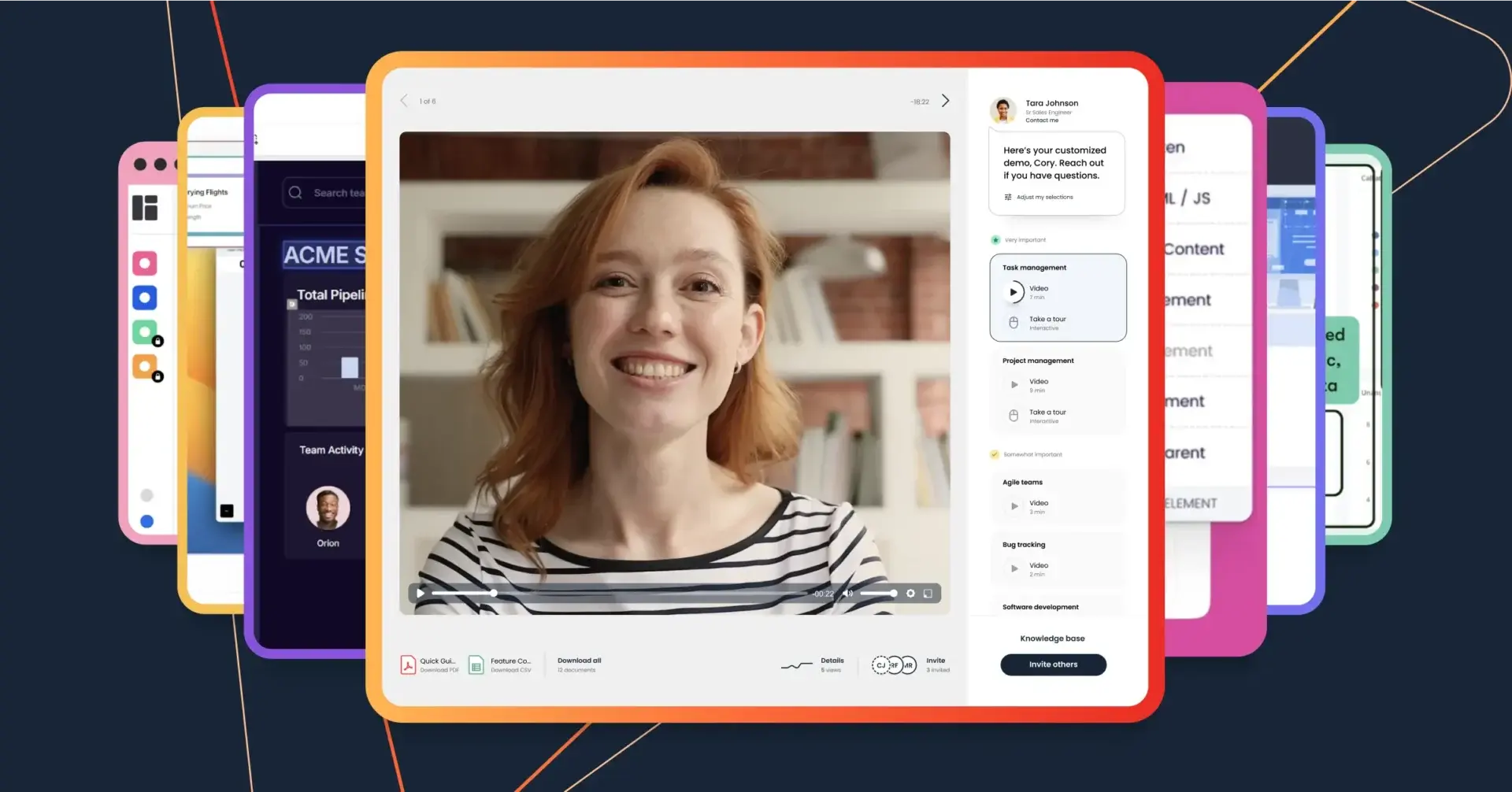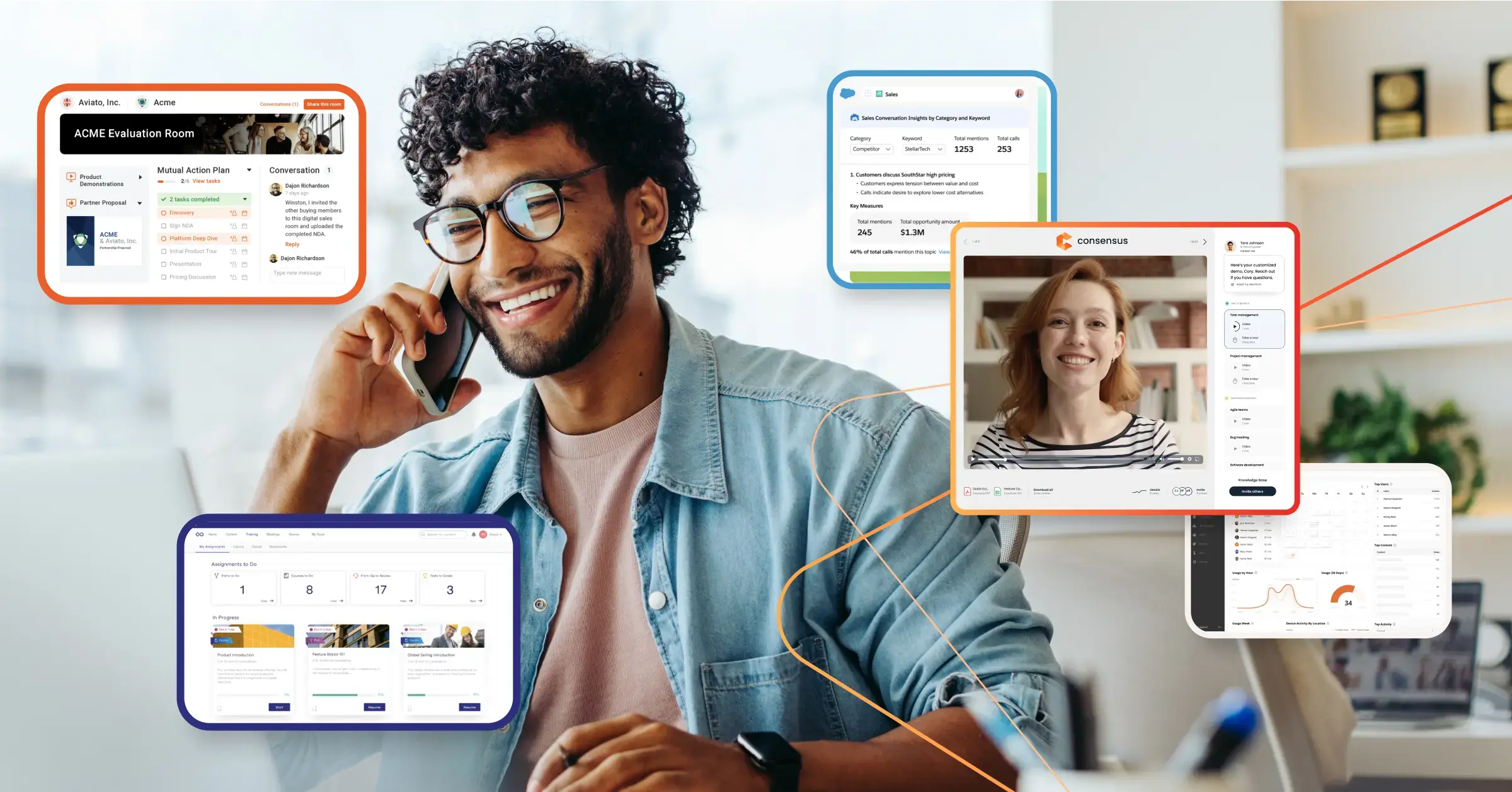Close more deals with
Demo Automation.
Watch a Demo
Face it: Your sellers can’t be everywhere at once (and your buyers don’t want them to be). While the average buying journey in B2B sales lasts about 11 months, your buyers are spending eight of those months researching on their own, not wanting to connect with sales teams yet.
With product-led marketing, your marketing, presales, and sales teams work together to demonstrate the value of your product through hands-on product experiences, even when your sellers aren’t in the room to show them the value themselves.
The result? Your buyers discover why your solution is really their solution all on their own. Let’s talk about how to develop your product-led marketing strategy.
What is Product-Led Marketing?
The days of relying solely on sales presentations and marketing collateral are behind us. Today’s technical buyers want to experience products on their own terms before engaging with sales, which is why more than half of businesses have adopted a product-led growth plan.
Product-led marketing represents a fundamental shift in how companies approach customer acquisition and engagement. Rather than relying on traditional marketing funnels that separate buyers from product experiences until late in the buying journey, product-led marketing puts the product at the center of every marketing activity. Buyers can experience your product’s value firsthand before making a purchase decision.
The core principle is simple yet powerful: let your product do the selling. Instead of just telling buyers about your solution through conventional marketing channels, you show them through interactive demos, free trials, and automated simulations that deliver immediate value.
Product-led marketing is particularly effective for complex B2B software purchases where multiple stakeholders are involved. For many B2B software purchases, the buying committee can end up having up to 20 stakeholders, so personalized product experiences are crucial for addressing their unique needs. With interactive, customized product experiences, you can address the concerns of technical users, business stakeholders, and executive decision-makers without requiring multiple sales calls.
Benefits of Creating a Product-Led Marketing Strategy
When buyers can experience products directly, sales cycles shorten and close rates improve. Product-led businesses are twice as likely to be growing quickly compared to their peers. Here are some of the benefits of moving toward a product-led marketing approach:
- Improves Buyer Enablement: Product-led marketing empowers buyers to educate themselves and make informed decisions at their own pace. Interactive demos and product tours allow buyers to explore solutions relevant to their specific challenges without sales pressure.
- Lowers Customer Acquisition Costs: Companies implementing product-led strategies see a nearly 10% lower acquisition cost than traditional sales-led strategies. This efficiency comes from letting the product itself qualify and convert leads, reducing the need for extensive sales resources early in the funnel.
- Enhances Customer Experience: When buyers can experience your product before purchasing, they develop more accurate expectations about its capabilities. This leads to higher satisfaction rates post-purchase and reduces the likelihood of buyer’s remorse or implementation challenges.
- Improves Alignment Between Revenue Teams: Product-led marketing naturally aligns marketing, sales, and product teams around the actual product experience. This alignment creates a more cohesive customer journey and eliminates the common disconnect between what marketing promises and what the product delivers.
By helping buyers see, hear, and try your product, you help buyers visualize outcomes, hear value in their own context, and try your product in a meaningful way. It’s how modern buyers want to learn, and it’s how modern teams accelerate conversions without adding friction.
Understanding Product-Led Marketing vs Product-Led Growth for B2B Companies
While product-led marketing is a marketing strategy that uses your product as the primary channel to attract and convert customers, product-led growth (PLG) is a broader business model where the product drives the entire customer journey, including acquisition, conversion, expansion, and retention.
Think of PLM as a subset of PLG, it’s one component of a larger product-led approach to business. While PLM focuses specifically on marketing activities like creating interactive demos and product tours to generate and convert leads, PLG encompasses everything from product development and pricing to customer success and expansion strategies.
For B2B companies, especially those with complex products, combining elements of both approaches often yields the best results. You can use product-led marketing tactics like interactive demos to generate high-intent leads while maintaining a sales-assisted approach for enterprise deals. This hybrid model gives you the best of both worlds.
For example, companies like Slack and Dropbox have successfully implemented both PLM and PLG. Their marketing focuses on getting users to experience the product through free versions (PLM), while their broader business strategy centers on making the product so valuable that users naturally upgrade and expand usage over time (PLG).
Key Principles of Product-Led Marketing
Successful product-led marketing requires rethinking your entire marketing strategy through the lens of product experience. Every touchpoint should give buyers a taste of what it’s like to use your solution, whether through interactive demos, guided tours, or limited free access.
The key principles of product-led marketing are:
Using the Product as the Main Marketing Channel
PLM leverages your product by creating opportunities for buyers to experience your solution’s value before committing to a purchase. This approach transforms your product from something buyers learn about to something they actively engage with during their buying journey.
Traditional marketing channels like content marketing, email campaigns, and social media still play important roles, but they serve a different purpose in product-led marketing:
- Drive to experience, not just information: Use traditional channels to direct buyers toward interactive product experiences rather than just providing information.
- Show, don’t tell: Replace feature descriptions with opportunities to experience those features firsthand, such as through an automated simulation.
- Focus on value moments: Highlight specific aspects of your product that deliver immediate value rather than comprehensive overviews.
When people buy online, they’re using three key senses: sight, sound, and feel. They want to visualize the solution, hear how it solves their problem, and feel confident in their decision through real engagement.
This is where most marketing stops short—by telling buyers what the product does, instead of letting them experience it for themselves. That’s where product-led marketing shines. And that’s where Consensus comes in.
Consensus is the world’s first product experience platform that targets these senses through interactive demos, product tours, and automated simulations. Through Consensus, sellers can create customized experiences that let their buyers watch, try, and explore their product.

With Consensus, sellers and marketers don’t just talk about value, they show it. The result? Shorter sales cycles, better-qualified leads, and stakeholders who are already aligned before the first call.
Ensuring Marketing Models Align with Product Launches
Successful product-led marketing requires tight coordination between marketing and product teams throughout the product development lifecycle. This alignment ensures that marketing strategies effectively showcase new features and capabilities while product development prioritizes elements that deliver clear, demonstrable value to buyers. That alignment—or lack thereof—affects your bottom line, since highly aligned sales and marketing teams can drive more than 200% more revenue from their marketing efforts.
Product launches present prime opportunities for product-led marketing initiatives. Rather than simply announcing new features through traditional channels, companies can create interactive experiences that let buyers explore these capabilities firsthand.
Prioritizing Data to Build Marketing Strategies
Buyer behavior data is worth its weight in gold. When we can see exactly which features a CFO explores versus what interests a technical buyer, we gain unprecedented insight into stakeholder priorities.
Unlike traditional marketing metrics that focus primarily on engagement with marketing materials, product-led marketing prioritizes data about how buyers interact with your product experiences. Usage data reveals which features buyers find most valuable and which they struggle to understand or adopt. This information helps marketing teams craft more effective messaging that highlights the capabilities that truly resonate with potential customers.
Imagine you’re using a demo automation platform and sending out interactive demos to buyers. With an advanced analytics tool, like Consensus’ Demolytics, you can get in-depth data on how your buyers and their company’s stakeholders interact with your demo. Learning metrics like what parts of the demos are rewatched the most, which demos are being shared the most, and which key stakeholders have been discovered helps shape your next interactions with your buyers, effectively and efficiently improving your marketing.

How to Build a Product-Led Marketing Model
The transition to product-led marketing doesn’t happen overnight. It requires coordination across teams, investment in the right technologies, and a willingness to experiment with new approaches. However, the results—higher conversion rates, lower acquisition costs, and more satisfied customers—make this transition worthwhile for most B2B companies. Here’s where to start:
1. Understand Your Buyers’ Pain Points
Effective product-led marketing starts with a deep understanding of your buyers’ challenges and objectives. This understanding allows you to create product experiences that directly address specific pain points, demonstrating immediate value to buyers.
Methods for gathering buyer insights include:
- Customer interviews: Direct conversations with existing users about their challenges and how your product solves them
- Support ticket analysis: Patterns in customer questions and issues that reveal common pain points
- Sales call reviews: Concerns and objections that arise during the sales process
- Usage data examination: Features that receive the most engagement from satisfied customers
Create detailed buyer personas that include not just demographic information but also specific workflows, challenges, and success metrics for each stakeholder in the buying process. For complex B2B purchases, understanding the distinct concerns of different types of decision-makers helps you create targeted product experiences for each group.
2. Create Problem-Solving Content
Product-led marketing requires content that demonstrates how your solution solves specific buyer problems, not just describing features. This content should provide interactive experiences that let buyers see exactly how your product addresses their unique challenges.
Effective problem-solving content types include:
- Interactive demos: Create personalized demo journeys that allow buyers to see what makes your solution the one for them.
- Product tours: Let buyers try your product in a controlled, contextualized guided tour that lets you highlight key features without needing to be in the room.
- Automated simulations: Give buyers instant access to try out your product through sandboxes and proof of concept (POC) experiences.
Using problem-solving content in marketing goes hand-in-hand with the selling approach of gap selling. With gap selling, your goal is to help a buyer uncover the gap that exists between where they are now and where they want to be, and how your product helps fill that gap.
While defining the gap is essential to guiding the sale, it’s also where teams can lose traction. You can have the perfect discovery call, map out the buyer’s current and future state, and align on a compelling vision—but then there’s a lull. Days or even weeks pass between meetings. And during that time, buyers are still researching, inviting new stakeholders, and comparing competitors. You’re not in the room, but your competition might be.
With Consensus’ personalized product experiences, buyers get hands-on support with a hands-off approach. Your demos and product tours don’t sleep, they’re always working, always available, and always aligned to your buyer’s current and future state.
3. Get Feedback From Your Buyers
Continuous feedback from buyers and customers helps refine both your product and marketing approaches. In product-led marketing, this feedback takes on additional importance since it helps you understand which product experiences resonate most effectively with different buyer personas.
Implement in-app surveys and feedback tools that capture buyers’ reactions to your product experiences in real time. These tools provide immediate insights into which features generate excitement and which create confusion, helping you refine your demonstrations to highlight the most compelling capabilities.
You can also conduct user testing sessions with buyers to observe how they interact with your product demos and tours. These sessions often reveal unexpected pain points or moments of delight that can inform both product development priorities and marketing messaging. Pay particular attention to the questions buyers ask during these sessions, since they highlight areas where your product experiences could provide more clarity.
4. Track Key Metrics
Unlike traditional marketing, which focuses primarily on lead generation metrics, product-led approaches require tracking how buyers engage with your product and how those interactions influence purchase decisions.
Product-qualified Leads
Product-qualified leads, sometimes called intent-qualified leads or demo-qualified leads, are strong potential buyers who meet several criteria indicating demand for your product. These leads fit your ideal client profile and already appreciate your product’s value. Behaviors will vary based on your product and marketing funnel structure. But in most cases, a PQL has likely engaged in:
- Watching the majority of your demo videos
- Sharing your interactive demo with their team lead
- Signing up for your free trial
- Using a free version of your product
- Logging in to your platform frequently
PQLs aren’t just “interested,” they’re already engaged. By surfacing them earlier in the funnel, your sales team can focus on buyers most likely to convert.
Activation Rate
Activation rate measures the percentage of buyers who reach key value moments in your product demonstrations. This metric helps you understand how effectively your product experiences deliver value to potential customers.
A high activation rate indicates that buyers are discovering capabilities that address their needs, while a low rate suggests your demonstrations may not be highlighting the right features or may be too complex to navigate. The average activation rate for B2B businesses is 37.5%, which may be a good benchmark to aim for.
To improve activation rates, identify the specific interactions that indicate a prospect has experienced value from your demonstration. Then optimize your product experiences to guide more users toward these key moments.
Engagement
Engagement metrics reveal how deeply buyers interact with your product experiences. These include time spent exploring demonstrations, the number of features explored, and the frequency of return visits.
Strong engagement indicates that buyers find your product relevant to their needs, while weak engagement suggests a misalignment between your solution and prospect expectations or difficulties in navigating your demonstrations.
Track not just overall engagement but also which specific features attract the most attention from different buyer personas. This information helps you tailor follow-up communications to address the capabilities each stakeholder cares about most.
Key engagement metrics to monitor:
- Time spent: Duration of interaction with your product experiences
- Feature exploration: Number and types of capabilities buyers investigate
- Return rate: Frequency of repeat visits to product demonstrations
- Sharing activity: How often and which aspects buyers share with colleagues
- Demo qualified leads: The percentage of viewers who enter their contact data into a lead form on a website CTA demo
- Demo Automation Effect on Revenue Growth: Total revenue influenced by official automated demo content
Demolytics can be a handy tool to use to measure product-led marketing engagement. By tracking metrics like who is sharing your demos, who is watching them, and which demos are watched the most, you’ll learn about your buyers through their intent data, which might tell you more than they’re able to tell you themselves.
Conversion Rate
Unlike traditional marketing conversion rates that measure progression through awareness and consideration stages, product-led conversion metrics focus on how product interactions accelerate buying decisions.
The most important conversion points include:
- Demo-to-meeting conversion: Buyers requesting sales conversations after experiencing your product
- Demo-to-customer conversion: Buyers who purchase after engaging with demonstrations.
- Demo-to-trial conversion: Buyers who opt into a free trial or freemium experience after viewing a demo
- Trial-to-paid conversion: Users who convert from a free trial or freemium version to a paid plan
- Multi-stakeholder activation: When multiple stakeholders from the same account engage with your demo or product experience
By analyzing which product experiences lead to the highest conversion rates, you can optimize your product experiences to highlight the capabilities that most effectively drive purchases.
User Retention
User retention shows whether buyers continue to engage and find value after their initial product experience or purchase. In a product-led model, this is a direct reflection of:
- How accurately demos set expectations
- How well onboarding delivers on those expectations
- The ongoing usability and perceived value of your solution
Revenue-per User
This metric tells you the monetary value of each user, on average. In product-led marketing, it helps you understand:
- Which demos or experiences lead to higher-value deals
- Whether buyers coming through product experiences generate more upsell/cross-sell opportunities
Don’t forget to track expansion revenue, especially in B2B, where multiple departments may adopt the product post-sale.
NPS
NPS tracks customer satisfaction by measuring how likely users are to recommend your product. In a product-led strategy, high NPS indicates that your product:
- Met or exceeded expectations set during the demo phase
- Delivered clear, immediate value
- Encouraged champions within your customer’s organization
A high NPS often signals healthy word-of-mouth growth, the fuel of efficient pipeline building.
Customer Lifetime Value
CLV measures the total revenue you can expect from a customer over the course of their relationship with your company. In a product-led environment, CLV is closely tied to:
- The quality of the initial product experience
- How quickly users activate and adopt
- Retention and expansion patterns over time
Optimizing demos and free trials for fast value discovery can increase LTV by driving more successful long-term relationships.
5. Use Product Experience Software
More than 75% of people say that they are more likely to purchase, recommend, and repurchase from a company that provides personalized product experiences. But you can’t just personalize for every customer. You also need to personalize for every stakeholder. But that’s nearly impossible without product experience software.
Product experience platforms assist with product experience management (PXM), which focuses on creating a cohesive, customized product experience for each buyer. They enable you to create, share, and analyze these experiences by storing all product information, assets, content, and analytics in one place and using them to optimize every touchpoint of the buyer’s journey.
With Consensus, you get a product experience platform designed to make product-led marketing simple. Instead of individually customizing every product interaction, Consensus automates the personalization process—buyers tell Consensus what matters most to them, and Consensus builds a customized product experience path. With Demolytics, your sellers track their engagement and discover when and how to connect next.

Examples of Product-Led Marketing
Product-led marketing takes many forms across different industries and product types. These real-world examples demonstrate how companies successfully implement product-led strategies to drive growth and customer acquisition.
HubSpot: HubSpot offers free marketing, sales, and service tools that deliver immediate value while showcasing the capabilities of its premium CRM platform. The Website Grader tool, for example, provides valuable insights to buyers while demonstrating HubSpot’s expertise in digital marketing.
Ahrefs: This SEO tool provider offers a free website audit tool that demonstrates the power of their platform while providing valuable insights to potential customers. By letting buyers experience a portion of their product’s capabilities without a subscription, Ahrefs builds trust and demonstrates value upfront.
Construction software: This company’s solutions consulting (SC) team used Consensus to create more than 500 pieces of content to enable sales reps to engage buyers at different stages of the buyer’s journey. Automated demos quickly became a preferred lead source for the company. Placing demos strategically on the website where buyers are most likely to spend time and express interest turned their product into its best-converting asset. Not only did demos produce more than 4,300 leads through the website, it outperformed other traditional marketing assets by 4X.
The common thread across these examples is letting buyers experience product value before making a purchase decision. This approach builds trust, demonstrates capabilities more effectively than traditional marketing materials, and creates more qualified leads for sales teams.
Use Product-Led Marketing to Unlock High-Intent Leads
Product-led marketing represents a powerful strategy for generating and converting high-intent leads in today’s self-directed buying environment. By allowing buyers to experience your product’s value firsthand, you create more qualified opportunities and accelerate sales cycles.
The key to success lies in creating interactive product experiences that demonstrate clear value to each stakeholder in the buying process. These experiences should focus on solving specific problems rather than showcasing features, helping buyers envision how your solution addresses their unique challenges.
Implementing product-led marketing requires the right technology, particularly for complex B2B solutions. Consensus helps companies create personalized, interactive product demonstrations that buyers can explore at their own pace. Highlight different capabilities for different stakeholders while gathering valuable insights into which features resonate most with potential customers. The result? Product-qualified leads who understand the value of your solution and are more likely to convert.
Ready to see how Consensus can help you implement product-led marketing? Experience a demo to discover how our platform enables interactive product experiences that convert high-intent leads.
Product-led marketing flips that script. It puts the product front and center – letting buyers see, hear, and try before they buy. Through interactive demos, free trials, and self-guided tours, buyers explore value on their own terms. Instead of being told how your product works, they experience it firsthand.
This hands-on model not only builds trust faster—it also drives higher-quality leads, lowers acquisition costs, and shortens sales cycles. When buyers discover value for themselves, they’re already halfway to “yes” before your team ever gets involved.





